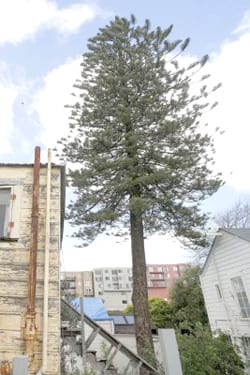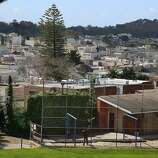By: Emily Green
The S.F. Chronicle and The S.F. Urban Forestry Council deems this 100 foot-tall Inner Richmond tree worthy of protection.
A San Francisco property owner should not be allowed to cut down a 100-foot pine tree in his backyard, a city environmental committee decided Friday, siding with neighbors who want to landmark the tree over the owner’s objections.
In a 9-2 vote, the Urban Forestry Council concluded Friday that the tree should be landmarked because of its physical attributes, rarity, environmental benefits and cultural support. The question will now be forwarded to the Board of Supervisors for a vote. The board has historically followed the council’s advice.
The fate of the tree had become so contentious that the owner hired a lawyer, while neighbors who wanted to preserve the tree obtained restraining orders prohibiting its removal. One side even consulted a shaman in Indonesia about the tree’s future. Some two dozen people showed up to the council’s meeting Friday to support or oppose the landmark status.
If it all sounds like a wacky San Francisco story, the dispute also underscores an important question: How much say should property owners have over their land?
At a meeting in January, the Urban Forestry Council deadlocked 5-5 on whether to landmark the pine tree. One member, who was not present at that meeting, voted Friday to landmark, while three members who had originally voted against landmarking changed their votes.
Council member Michael Sullivan was one of them. He said after further consideration, the tree appeared to be sufficiently rare to warrant protection, even though he still had reservations.
“In general, I think we ought to defer to property owners when a tree is in the backyard. I think we have to be really rigorous about … not landmarking every large tree that comes before us even if it tugs at our heartstrings,” he said.
Member Carla Short voted not to landmark. She said that while the tree is beautiful and should not be cut down, it did not meet the criteria. Among the factors the council considers are a tree’s size, age, history and importance to the environment. Short urged the council to develop an alternative for protecting big trees that do not rise to landmark status.
Yolanda Manzone, who voted to landmark the tree, said the decision was difficult. “The precautionary principle tells us — we need to take the course that is most risk averse. For me that means designating it as a landmark because this is such a close call.”
But Dale Rogers, the property owner, told the council that voting to landmark the tree amounts to the “taking of one’s private property against their wishes.” And, he said, it also had more practical impacts. It hindered his efforts to use solar power for his house, and one insurance carrier canceled his policy, citing the tree’s potential to cause damage.
Vanessa Ruotolo, a neighbor who spearheaded the landmarking effort, said she was gratified by the council’s decision.
“It took a lot more time than we thought it would, but we as a community learned so much in the process and are grateful that this magnificent tree will continue to be part of our beloved neighborhood.”
Emily Green is a San Francisco Chronicle staff writer. Email: egreen@sfchronicle.com



